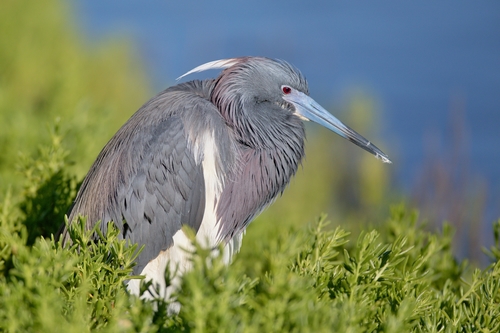
Tricolored Heron
The Tricolored Heron (Egretta tricolor), formerly known in North America as the Louisiana Heron, is a medium-sized heron recognizable for its slender build, long neck, and distinctive plumage. It plays a crucial role in wetland ecosystems as a predator of small fish and amphibians, helping to regulate populations within these environments. Unlike some more gregarious heron species, the Tricolored Heron often forages alone, exhibiting a patient and deliberate hunting style. It is not considered to have any specific cultural significance beyond its general appreciation as a graceful and beautiful bird.
56-76 cm
Length
90-100 cm
Wingspan
Least Concern
Conservation Status
Distribution
The Tricolored Heron is found along the Atlantic coast of North America from the northeastern United States down to Florida and the Gulf Coast, extending into Mexico, Central America, the Caribbean, and northern South America (as far south as Brazil and Peru). It is primarily a coastal species, though some populations venture inland along rivers and large lakes. It is generally non-migratory in tropical areas, but northern populations may migrate south in winter.
Lifespan
The average lifespan in the wild is not well documented, but similar heron species live 7-15 years. *Not Evaluated*
Tricolored Heron's Habitat
Habitat Types
Coastal marshes, Mangrove swamps, Estuaries, Salt marshes, Lagoons, Mudflats
Climate Zones
Tropical, Subtropical, Temperate
Adaptations
Their long legs and toes are adapted for wading in shallow water, allowing them to navigate through dense vegetation and soft substrates. Their sharp, pointed bill is perfectly suited for spearing fish and other small prey.
Variations
Several subspecies have been proposed, but there is ongoing debate about their validity. Some recognized subspecies include *Egretta tricolor ruficollis* (found in much of North America) and *Egretta tricolor tricolor* (found in South America). Differences between subspecies are primarily based on subtle variations in plumage color and size.
Appearance
Breeding Plumage
Breeding adults develop long, slender plumes on their head, neck, and back. The colors of the soft parts (bill, legs, and lores) become more intense during the breeding season. Non-breeding adults have duller plumage and lack the long plumes.
Seasonal Feather Changes
Plumage colors are generally more vibrant during the breeding season.
Sex Based Plumage Differences
There is minimal sexual dimorphism in plumage, although males may have slightly longer plumes during the breeding season.
Notable Features
Slate-blue upperparts, White belly and underwing linings, Reddish-purple neck and breast during breeding, Long, slender, yellowish to grayish bill
Diet and Feeding
Primary Foods
Small fish, Crustaceans, Amphibians, Insects, Reptiles
Foraging Behavior
The Tricolored Heron is a patient and deliberate hunter. It often stands motionless in shallow water, waiting for prey to come within striking distance. It may also slowly stalk its prey or use its feet to stir up the substrate and flush out hidden animals. They are known to use a technique called 'canopy feeding' forming a canopy with their wings to attract fish.
Specializations
Its long, sharp bill is a specialized tool for spearing fish and other small, aquatic animals.
Seasonal Diet Variations
Diet may vary slightly depending on prey availability, which can fluctuate seasonally. For example, they may consume more crustaceans during certain times of the year. *Not Evaluated*
Behavior
Social Structure
Tricolored Herons are often solitary foragers, but they nest in colonies, sometimes mixed with other heron and egret species. Outside of the breeding season, they may be found in small groups.
Communication
Various croaks and squawks, Bill snapping, Visual displays (posturing, plume raising)
Migration
Northern populations are migratory, moving south to warmer climates for the winter. Southern populations are generally resident or make shorter, local movements in response to water levels.
Territorial or Group Behaviors
They defend small feeding territories, especially during the breeding season. Within nesting colonies, they defend the immediate area around their nest.
Conservation
Threats
Habitat loss and degradation (due to coastal development, wetland drainage, and pollution), Human disturbance (at nesting colonies), Climate change (sea-level rise, altered rainfall patterns), Pesticide contamination
Protection Programs
Migratory Bird Treaty Act (in the US), Various wetland conservation and restoration programs, CITES Appendix III (in some countries)
Local National Laws
Protected under various state and national laws in the US and other countries within its range.
Population Trend
Stable
Population Estimates
The global population is estimated to be around 280,000 individuals.
Interesting Facts
They are one of the most slender herons.
This allows them to move easily through dense marsh vegetation.
They were once known as Louisiana Herons.
The name was changed to Tricolored Heron to better reflect their wider distribution.
They sometimes use their wings to create shade.
This 'canopy feeding' technique helps them see prey more easily and may also attract fish.
Faqs about Tricolored Heron
What is the difference between a Tricolored Heron and a Little Blue Heron?
Adult Tricolored Herons are easily distinguished by their white belly and underwing linings. Little Blue Herons are entirely slate-blue as adults. Juvenile Little Blue Herons are white, but they have greenish legs and a two-toned bill, unlike Tricolored Herons.
Where can I see a Tricolored Heron?
Look for them in coastal marshes, swamps, and estuaries along the Atlantic and Gulf coasts of North America, and throughout the Caribbean and Central America.
Are Tricolored Herons endangered?
No, they are currently classified as Least Concern by the IUCN, meaning they are not considered to be globally threatened. However, local populations may be declining due to habitat loss.
Copyright @ Nature Style Limited. All Rights Reserved.
 English
English